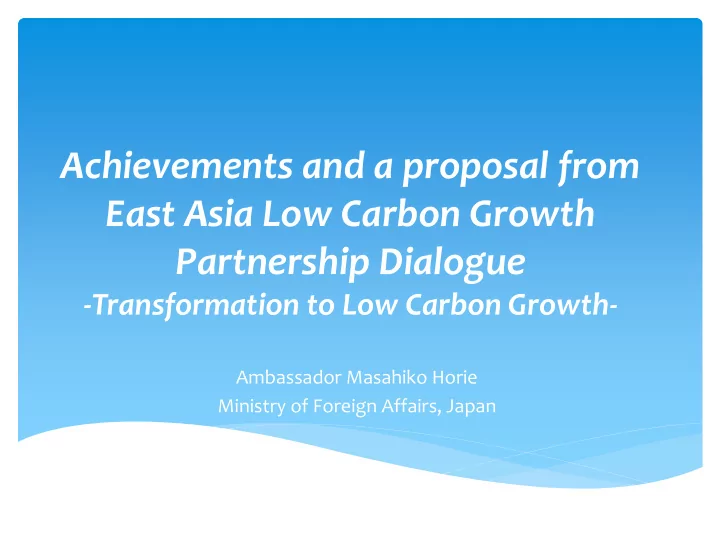

Achievements and a proposal from East Asia Low Carbon Growth Partnership Dialogue -Transformation to Low Carbon Growth- Ambassador Masahiko Horie Ministry of Foreign Affairs, Japan
East Asia Summit Region Members of EAS Percentage of CO 2 emitted by EAS member countries in the world(2012) ASEAN(Brunei, Cambodia, Indonesia, Laos , Malaysia, Myanmar, Philippines, Singapore, Thailand, Viet Nam), Australia, China, India, Japan, New Zealand, Russia, South Korea, USA, China 26.0% Total : 18 countries Non-EAS EAS Approximately Features of EAS 37% Approximately 63% • the center of gravity of USA the world economy 16.0% Australia India • approximately 63% of 1.2% 6.2% Indonesia world’s CO 2 is emitted by 1.4% Japan Russia South EAS member countries 3.9% 5.2% Korea 1.9% Source : IEA(2014) “CO2 emissions from fuel combustion highlights” → To promote and realize the low carbon economic growth within EAS region “East Asia Low Carbon Growth Partnership Dialogue”
Past Achievements of the Partnership Dialogues 1 st Dialogue: Ministerial 2012.4 Low-carbon growth realizes “Sustainable Economic • Growth” 1. The development and the implementation of low carbon growth strategy in each country 2. The importance of technology and market mechanism 3. The development and the enhancement of networks among various stakeholders Establishment of “East Asia Knowledge Platform for Low- • carbon Growth” 2 nd Dialogue: Ministerial 2013.5 Importance of “Technology” • Public-Private Partnership – The transfer of appropriate technologies – Market Mechanism – 3 rd Dialogue: High Level 2014.10 Importance of “Technology Transfer” and “Cities’ Actions” • The long term certainty of climate policies and actions – Beyond public-private partnership –
The 4 th East Asia Low Carbon Growth Partnership Dialogues 2015.12 Expecting Outcomes: • Sharing a proposal from East Asia Low Carbon Growth Partnership Dialogues • Sharing best practices – NAMA/MRV framework in Vietnam – JCM in Cambodia – Implementation of JCM in Asia – Building energy/GHG monitoring scheme in Putrajaya, Malaysia • Panel Discussion “ Actions for the Post-2015 ” • Open Discussion
East Asia Low Carbon Growth Partnership East Asia Summit(EAS), EAS Ministerial Meetings report East Asia Low Carbon Growth Partnership Dialogue Confirmation of the importance of low Sharing of best practices and carbon growth at the high political level knowledge in the region Building of “Asian models” for low carbon growth Pillar 1 Pillar 2 Pillar 3 The development and Utilization of The development of the implementation of technologies and market effective networks each countries’ low mechanisms among various carbon growth strategy stakeholders finance Capacity technologies Building Realization of low carbon growth in EAS region
Three Pillars and Elements of the Proposal Pillar 1: The development and the implementation of each country’s low carbon growth strategy Local governments and industrial communities play an important role to develop and • implement low-carbon growth plans which need to be developed based on scientific viewpoints and country’s/local area’s characteristics. e.g. (1) A scenario for future local government’s low carbon growth strategies in Iskandar Malaysia (2) Energy/GHG monitoring scheme in Putrajaya , Malaysia (3) NAMA/MRV framework in Vietnam Pillar 2: Utilization of technologies and market mechanisms Governments need to provide economic incentives, stable policy frameworks, and • maintenance of investment and business environments to cooperate with private sectors to disseminate appropriate low carbon technologies. e.g. (1) JCM in Cambodia (2) Implementation of the JCM City-to-City collaboration needs to be enhanced for technology dissemination and • capacity building. Pillar 3: The development of effective networks among various stakeholders Developing global partnerships among all stakeholders needs to be promoted. • Utilize existing networks should be further activated. • e.g. (1) the East Asia Low Carbon Growth Knowledge Platform (2) LoCARNet (Low Carbon Asia Research Network)
Recommend
More recommend